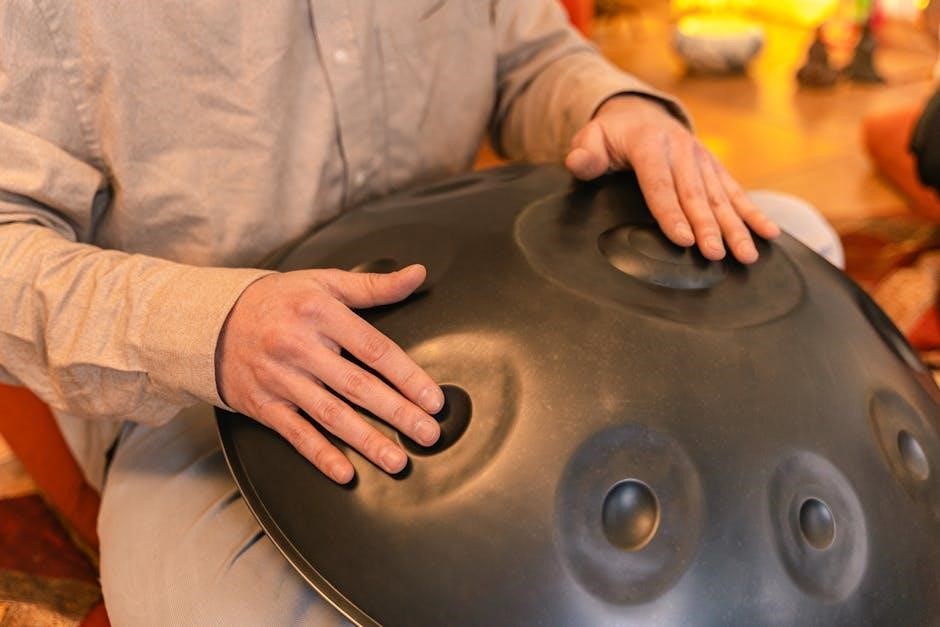Percussion rudiments are the foundational elements of drumming, consisting of basic strokes and rhythms. They are essential for developing technical proficiency and musical expression. Resources like the Vic Firth website and PAS PDF guides offer comprehensive breakdowns, making them invaluable for drummers of all levels. These materials provide detailed instructions, demonstrations, and practice exercises to master the 40 essential rudiments, ensuring a solid foundation for both beginners and advanced players.
1.1. Definition and Importance of Rudiments in Drumming
Percussion rudiments are the fundamental rhythmic patterns and strokes that form the basis of drumming technique. They include basic movements like single strokes, double strokes, flams, and drags. Mastering these rudiments is crucial as they improve coordination, timing, and overall musical expression. Resources such as the Vic Firth and PAS PDF guides provide detailed explanations and exercises, making them indispensable for drummers aiming to build a strong foundation and advance their skills effectively.
1.2. Brief History of Percussion Rudiments
Percussion rudiments have their roots in military and classical drumming, where specific strokes were used for communication and rhythmic precision; Over time, these basic patterns evolved into a standardized system of 40 essential rudiments. Organizations like the Percussive Arts Society (PAS) have formalized and categorized these rudiments, making them accessible through resources like downloadable PDF guides. Mastering these foundational elements is considered essential for developing technical proficiency and musical expression in drumming.
1.3. Why Learning Rudiments is Essential for Drummers
Mastering percussion rudiments is crucial for building technical proficiency, improving timing, and enhancing musical expression. They serve as the foundation for all drumming styles, allowing Drummers to execute complex rhythms with precision. Resources like downloadable PDF guides and video tutorials provide structured learning paths, making rudiments accessible to all skill levels. By focusing on these fundamentals, Drummers can develop the skills necessary to excel in various musical genres and performance settings, ensuring a strong and versatile foundation for their craft.

The 40 Essential Percussion Rudiments
The 40 rudiments are the building blocks of drumming, covering single strokes, double strokes, flams, and drags. They form the foundation for rhythmic expression and technical mastery, applicable across all musical genres and styles.
2.1. Overview of the 40 Rudiments and Their Categories
The 40 percussion rudiments are categorized into four main groups: single strokes, double strokes, flams, and drags. Each category focuses on specific techniques, such as stroke types, rhythmic placements, and accentuations. These rudiments serve as the foundational building blocks for all percussive music, enabling drummers to execute complex rhythms with precision and control. Understanding and mastering these categories is essential for versatility in various musical genres and styles.
2.2. Tiered Learning System for Mastering Rudiments
The Tiered Learning System organizes the 40 rudiments into skill levels, starting with basics like single strokes and rolls. Each tier introduces complexity, such as double strokes and flams, ensuring a gradual progression. This system combines technical difficulty and musical application, allowing drummers to master foundational techniques before advancing. It likely includes structured exercises and metronome use for timing, with practical application in musical contexts. The system is flexible, accommodating different learning paces, and may be supported by instructional resources for both self-taught and formally trained drummers.
2.3. Common Rudiments Every Drummer Should Know
Essential rudiments include the single stroke roll, double stroke roll, paradiddle, and flam. These form the foundation of rhythmic expression and versatility. Drummers should master the single stroke roll for clarity and timing, while the double stroke roll enhances speed and control. The paradiddle combines single and double strokes, offering rhythmic variety. Flam rudiments add dynamic accents, while drags and ruffs provide rhythmic complexity. These rudiments are universally applicable across genres, making them indispensable for drummers.
Single Stroke Rudiments
Single stroke rudiments form the foundation of drumming, focusing on clarity and timing. They include the single stroke roll and four, essential for building versatility and rhythmic precision.
3.1. Single Stroke Roll: Technique and Applications
The single stroke roll is a fundamental rudiment where notes are played with alternating single strokes. Proper technique involves a relaxed grip, wrist motion, and consistent timing. It’s widely used in various genres for grooves, fills, and rhythmic patterns. Mastery of the single stroke roll enhances versatility and precision, making it a cornerstone for both beginner and advanced drummers. Regular practice ensures smooth execution and adaptability in diverse musical settings.
3.2. Single Stroke Four: Timing and Control
The single stroke four consists of four consecutive single strokes played in a rhythmic sequence. Emphasizing timing accuracy, it’s often used in grooves and rhythmic patterns. Practicing with a metronome helps develop precise control. Starting at slower tempos ensures clarity before increasing speed. This rudiment is versatile, appearing in genres like jazz and rock, and enhances a drummer’s ability to execute complex rhythmic figures with consistency and precision.
Double Stroke Rudiments
Double stroke rudiments involve two consecutive strokes with each limb, building speed and endurance. They form the foundation for complex rhythms and technical mastery in drumming.
4.1. Double Stroke Roll: Building Speed and Endurance
The double stroke roll involves alternating strokes with each limb, creating a smooth, even sound. It is a cornerstone for building speed, endurance, and technical precision. Proper technique requires relaxed wrists and controlled forearm movement. Practicing with a metronome helps develop consistent timing and coordination. Start at slower tempos and gradually increase speed as control improves. This rudiment enhances muscle memory and prevents fatigue, making it essential for advanced playing. Mastering the double stroke roll opens the door to more complex rudiments and dynamic musical expression.
4.2. Double Stroke Four: Rhythmic Variations
The double stroke four emphasizes rhythmic accuracy and timing control. It involves two strokes from each limb, creating a dynamic rhythm. This rudiment is versatile, allowing for variations in tempo and groove. Practicing with a metronome helps refine timing, while exploring subdivisions enhances musicality. The double stroke four is essential for developing coordination and precision, making it a foundational element in advanced drumming techniques and genre-specific playing styles.

Flam Rudiments
Flam rudiments add dynamic expression to drumming with their unique “flaming” sound. They involve two notes played in quick succession, creating a bright, crisp effect. Common variations include the flam tap and flam accent, which enhance rhythmic complexity and musicality in various genres. Proper wrist and finger control are essential for executing flams effectively, making them a key element in advanced percussion techniques.
5.1. Flam Tap: Proper Technique and Timing
The flam tap is a fundamental rudiment combining two notes played in quick succession. Proper technique involves a relaxed wrist motion, with both sticks striking the surface simultaneously. Timing is critical, as the two notes should be evenly spaced and precise; Practice with a metronome to ensure accuracy. Mastering the flam tap enhances rhythmic clarity and expression, making it a vital skill for drummers aiming to refine their technical proficiency and musicality.
5.2. Flam Accent: Adding Expression to Your Playing
The flam accent is a dynamic rudiment that combines a grace note and a primary note, creating a rich, full sound. Proper technique involves a relaxed wrist motion, with both sticks striking the surface near simultaneously. Timing is crucial, as the two notes should be evenly spaced. This rudiment adds expression and depth to rhythmic patterns, making it versatile for various musical genres, from jazz to orchestral performances.
Drag Rudiments
Drag rudiments involve rhythmic placements that add complexity and texture to musical patterns, emphasizing timing precision and stick control for expressive drumming techniques.
6.1. Drag: Understanding Rhythmic Placement
The drag rudiment involves a rhythmic placement where a grace note is played before the main note, creating a subtle, nuanced sound. It is often used in snare drumming and parade drumming to add rhythmic interest. Proper timing and stick control are essential to execute drags effectively, as they require precise placement within the rhythm. This rudiment enhances musicality and expression in various percussion pieces.
6.2. Double Drag: Combining Rudiments for Complex Rhythms
The double drag combines two drags in a single rhythmic figure, creating intricate timing and phrasing. It involves playing two grace notes before a main note, demanding precise control and coordination. This rudiment is often used in advanced musical compositions to add complexity and texture. Mastering the double drag enhances a drummer’s ability to execute sophisticated rhythms with clarity and precision, making it a valuable skill for professional percussionists.
Learning Resources for Percussion Rudiments
Discover the best PDF guides, websites, and video tutorials offering detailed rudiment breakdowns, practice exercises, and expert demonstrations to master all 40 essential percussion rudiments effectively.
7.1. Best PDF Guides for Percussion Rudiments

Premium PDF guides offer comprehensive breakdowns of all 40 rudiments, complete with exercises and drills. Titles like Stick Control and The Art of Tambourine and Triangle Playing are highly recommended. These resources provide clear instructions, rhythmic patterns, and practice routines tailored for drummers of all levels. Downloadable from educational websites and platforms like Amazon, they are essential tools for mastering timing, technique, and muscle memory. Start with these guides to build a strong foundation in rudimental percussion.
7.2. Recommended Websites for Rudiment Breakdowns
Websites like vicfirth.com, drumrudiment.com, and pas.org provide detailed breakdowns of percussion rudiments. These platforms offer free resources, including video tutorials, interactive lessons, and downloadable PDFs. They cater to all skill levels, from beginners to advanced drummers. Use these sites to enhance your understanding of rudiments and improve your technique with structured learning materials and expert guidance.

7.3. Video Tutorials and Demonstrations
YouTube channels like DrumLessons365 and Mike Johnston offer high-quality video tutorials on percussion rudiments. Websites such as Drumeo and ArtistWorks provide structured lessons with demonstrations. These resources feature expert drummers breaking down rudiments into manageable parts, offering slow-motion views, and sharing practice tips. They are ideal for visual learners and complement PDF guides by showing real-time execution and proper technique.

Practice Tips for Mastering Rudiments
Consistency is key. Start with a structured daily routine, focusing on slow, accurate execution. Use a metronome to improve timing. Gradually increase speed as confidence grows. Prioritize muscle memory over complexity. Break rudiments into smaller parts and practice with relaxation to avoid fatigue. Make practice enjoyable to stay motivated and disciplined.
8.1. Setting Up a Daily Practice Routine
Consistency is crucial for mastery. Schedule a daily practice time, even if brief. Begin with warm-ups and rudiment-specific exercises. Break sessions into focused segments: technique, speed, and musicality. Prioritize quality over quantity, ensuring accuracy at slower tempos before increasing speed. Incorporate rudiments into musical contexts to enhance application. End with a cool-down to prevent fatigue. Stay motivated by tracking progress and celebrating small achievements.
8.2. Using a Metronome for Timing Accuracy
A metronome is essential for improving timing accuracy. Start with slower tempos to ensure clarity and precision, then gradually increase speed. This tool helps maintain consistent rhythms and prevents rushing or dragging; Regular use enhances your ability to play complex rudiments with confidence. Incorporate it into your daily practice to achieve better timing and overall musicality.
8.3. Building Muscle Memory Through Repetition
Repetition is key to building muscle memory, enabling rudiments to become second nature. Start with slow tempos, focusing on accuracy, and gradually increase speed. Consistent practice helps embed patterns into long-term memory, allowing seamless execution. Over time, this process reduces cognitive effort, freeing your mind for creativity and expression. Regular repetition is essential for mastery and fluid performance of percussion rudiments.
Common Mistakes to Avoid
Common mistakes include rushing or dragging tempos, poor stroke technique, and improper grip. Tension, inconsistent practice, and ignoring posture can hinder progress and lead to injury.
9.1. Incorrect Stroke Technique
Incorrect stroke technique is a prevalent issue, often due to poor grip, wrist positioning, or improper finger independence. This can lead to uneven tone, fatigue, and limited speed. Many drummers neglect to use their wrists effectively, relying too much on arm movement. Additionally, failing to strike the center of the drumhead results in poor sound quality. Practicing rudiments with a relaxed grip and focused strokes helps develop proper technique, as outlined in percussion rudiments PDF guides.
9.2. Rushing or Dragging Tempos
Rushing or dragging tempos disrupts rhythmic accuracy, often caused by inadequate practice or poor timing awareness. Drummers may unintentionally speed up during complex rudiments or slow down during simpler ones. To address this, using a metronome is crucial for developing consistent timing. Percussion rudiments PDF guides emphasize the importance of playing evenly, ensuring each note aligns with the beat. Regular practice with a metronome helps cultivate a strong internal clock and prevents tempo fluctuations.

Advanced Rudiment Combinations
Advanced rudiment combinations integrate single and double strokes with flams and drags, creating complex rhythms. These combinations enhance versatility and are widely used in jazz, classical, and modern genres. Regular practice with a metronome ensures precise execution and mastery of these intricate patterns, elevating a drummer’s technical proficiency and musical expression.
10.1. Combining Single and Double Strokes
Combining single and double strokes creates dynamic, intricate rhythms. Start with a single stroke roll, then transition into a double stroke roll for added complexity. This technique enhances speed and control, allowing drummers to execute advanced patterns seamlessly. Practice alternating between single and double strokes in various time signatures to build versatility. Begin slowly, focusing on accuracy, and gradually increase tempo for mastery. This approach is essential for solos and ensemble performances, showcasing technical proficiency and musicality.
10.2. Incorporating Flam and Drag Accents
Incorporating flam and drag accents adds emotional depth and rhythmic complexity to drumming. Flam accents involve a grace note preceding a primary stroke, creating a “flaming” sound, while drags extend rhythmic phrases. Start by practicing flams at slow tempos, focusing on evenness and control. Drags require precise timing to avoid rushing or dragging. Both accents enhance musicality and are essential for advanced rudimental playing across various genres.

The Role of Rudiments in Modern Drumming
Percussion rudiments form the foundation of modern drumming, enabling precise timing, versatility across genres, and dynamic musical expression, essential for both technical mastery and artistic adaptability.
11.1. Applying Rudiments in Different Genres
Percussion rudiments are versatile across genres, with each style incorporating them uniquely. Jazz often uses syncopation and rudimental-based Ride cymbal patterns, while Rock emphasizes power through Single and Double Strokes. Latin music relies on precise timing with Drags and Flams, and Classical drumming incorporates traditional rudiments for orchestral textures. This adaptability makes rudiments indispensable, regardless of the musical context, ensuring drummers can express themselves effectively in any setting while maintaining technical precision and musicality.
11.2. Rudiments in Solo and Ensemble Playing
Rudiments are fundamental to both solo and ensemble drumming. In solos, they provide the technical foundation for intricate rhythms and dynamic contrasts; In ensembles, rudiments ensure synchronization and rhythmic accuracy, fostering a unified sound. Drummers use rudiments to add flair in solos while maintaining precision in group settings, making them indispensable for both individual expression and collective musicality, regardless of the performance context or complexity.
Rudiments are the backbone of drumming, offering technical mastery and musical expression. Dedication and consistent practice unlock their full potential, enriching every drummer’s journey and performance quality.
12.1. Final Thoughts on the Importance of Rudiments
Percussion rudiments are the fundamental building blocks of drumming, essential for technical mastery and musical expression. They provide the skills needed to play with precision, versatility, and creativity. Whether you’re a beginner or an advanced drummer, rudiments form the foundation of all rhythmic playing. Regular practice and dedication to these basics will unlock your full potential, allowing you to excel in various musical genres and performance settings. Embrace rudiments as lifelong tools for growth and artistic expression.
12.2. Encouragement for Continuous Practice
Consistent practice is key to mastering percussion rudiments. Dedicate time daily to build technique and confidence. Start with short sessions, gradually increasing duration as skills improve. Use resources like PDF guides to structure your routine and track progress. Celebrate small victories to stay motivated. Remember, mastery takes time, but persistence will unlock your full potential as a drummer. Keep practicing, and the results will inspire you to continue growing musically.

Additional Resources
Explore detailed percussion rudiments PDF guides, online tutorials, and community forums. These resources offer in-depth lessons, practice exercises, and expert tips to enhance your drumming skills effectively.
13.1. Recommended Books and PDF Downloads
Enhance your rudiment mastery with essential books and PDF guides. Classics like Stick Control by George Lawrence Stone and The Art of Practicing by Madeline Bruser offer comprehensive lessons. Downloadable PDFs from reputable sources like the Percussive Arts Society (PAS) and the National Association of Rudimental Drummers (NARD) provide detailed charts and exercises. These resources are perfect for drummers seeking structured learning materials to improve technique and timing.

13.2. Online Communities and Forums for Drummers
Join active online communities like Reddit’s r/drums and r/percussion, where drummers share insights and resources. Drummer Cafe and Drum Forum host discussions on rudiments and PDF materials. Facebook groups like Drummers United offer networking opportunities. Engage with fellow musicians, ask questions, and access shared PDF guides on rudiments. These platforms foster learning, collaboration, and growth, providing valuable support for drummers at all skill levels.
13.3. Finding a Qualified Drum Teacher
Locate experienced drum instructors through local music schools or online directories like TakeLessons. Seek referrals from fellow musicians or online forums. Ensure the teacher specializes in rudiments and has a proven track record. Many instructors offer free trial lessons, allowing you to assess their teaching style and compatibility. A qualified teacher can provide personalized feedback, helping you master rudiments effectively and advance your drumming skills with precision and confidence.
